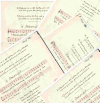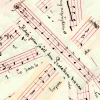O portálu Lidové prameny
Webový portál Lidové prameny slouží jako souhrnná platforma pro zpřístupňování rozsáhlého fondu záznamů lidových písní, hudby a tance. Portál vznikl v rámci výzkumů Etnologického ústavu AV ČR, jeho institucionálních předchůdců a dalších institucí. Portál zpřístupňuje shromážděná data o historických pramenech (rukopisech, tiscích, nahrávkách) a usnadňuje tak vyhledávání informací o záznamech hudebního a tanečního folkloru.
Úroveň přístupu pro veřejnost umožňuje vyhledat a zobrazit písňovou jednotku podle základních hledisek, jako jsou textový či melodický incipit (zpravidla první verš a jemu odpovídající počátek melodie), autor pramene (sběratel nebo vydavatel), lokalita a region zápisu, doba zápisu nebo druh tance. K vyhledaným datům portál zobrazuje notový zápis, sken pramene, případně digitalizovanou nahrávku. Portál tak poskytuje veřejnosti snadný přehled o písňových záznamech, které jsou jinými způsoby těžko dostupné. Systém poskytuje i nástroje pro podrobnější vyhledávání a srovnávání pramenů a písňových jednotek, a to včetně možností seskupování a filtrace hudebního a tanečního materiálu podle různých kritérií na základě provedené analýzy (v hudební oblasti např. rozsah písně, nejvyšší a nejnižší tón v dané tónině, počet taktů, hudební forma; v tanečním oboru podle počtu tanečníků, tanečních motivů, druhu držení apod.).
Písně
Digitalizované prameny jsou zpracovány coby písňové jednotky. Písňovou jednotkou rozumíme zápis textu písně, zápis nápěvu písně s textem, zápis instrumentální melodie nebo záznam tance v rámci konkrétního pramene. Při katalogizaci popisujeme zvlášť pramen (rukopis, tisk, nahrávku) a zvlášť jeho písňové jednotky. Součástí katalogizace hudebních pramenů, tj. kolekcí písňových a instrumentálních melodií, je digitalizace zápisu a provedení jeho komplexní hudební analýzy podle systému Lubomíra Tyllnera a Zdeňka Vejvody (Česká lidová píseň. Historie, analýza, typologie, 2019). Importem těchto dat na portál Lidové prameny vzniká možnost vyhledat konkrétní píseň podle tóniny a metra, zadáním části melodie na virtuální klaviatuře, nebo zvukovým vstupem – pískáním, zpěvem, či zahráním melodie na hudební nástroj. Díky tomu je také možné přehrávat zjednodušenou verzi melodie.
Prameny
Jako Pramen označujeme rukopisný, tištěný či audio(vizuální) záznam jedné nebo více písňových jednotek (tzv. sbírkový korpus) s uvedením bibliografického údaje nebo místa uložení a signatury. Pramen je dále pro účely katalogizace rozdělen do písňových jednotek. Pro účely katalogizace přiřazujeme každému prameni jednoznačný kód. Typicky obsahuje zkratku jména sběratele a zkratku názvu pramene. Volba kódu pramene vychází ze zavedených zvyklostí. Kódy českých pramenů shrnuje Průvodce po pramenech lidových písní, hudby a tanců v Čechách (Tyllner, Traxler a Thořová 2015).
Nejčastěji má v rámci jednoho pramene každá písňová jednotka právě jeden nápěv, a právě jednu variantu textu. Pokud bylo pod jedno číslo zahrnuto více písňových jednotek, liší se většinou textem (někdy také nápěvem nebo lokalitou zápisu). V takovém případě volíme pro první písňovou jednotku číslo zvolené autorem, a pro další písňové jednotky doplňujeme toto číslo vzestupně písmenem v hranaté závorce [b], [c]. V některých případech autor pramene v některých oddílech nepoužil číslování, nebo ho použil nepřehledně, takže nelze jednoznačně identifikovat písňovou jednotku v prameni nebo jeho části. V tom případě zavádíme pro katalogizaci písňových jednotek vlastní číslování, které vychází z pořadí písně v prameni, nebo z umístění písně na konkrétní straně pramene (číslo písně se pak skládá z čísla strany pramene a písmenného pořadí písňové jednotky na této straně). Dodatečné vlastní číslování signalizuje číslo písňové jednotky uzavřené v hranatých závorkách.
Lokality a regiony
U pramene i u konkrétní písňové jednotky bývá standardně uvedena lokalita a region záznamu. Tyto údaje portál Lidové prameny používá pro zobrazení písňové jednotky na mapě. Vychází přitom z mapování lokalit a regionů na body reprezentované GPS souřadnicemi, nebo označením obce či její části. Výchozí databází pro mapování je import veřejně dostupného seznamu obcí a jejich částí včetně zařazení do okresů a krajů České republiky. Lokality a regiony uvedené u jednotlivých písňových jednotek portál automaticky řadí i k prameni, který tyto písňové jednotky obsahuje.
Portál byl vytvořen v rámci projektu Lidové písně a tance českých zemí – digitální systém pro zpřístupnění a záchranu podpořeného v programu na podporu aplikovaného výzkumu a experimentálního vývoje národní a kulturní identity na léta 2016–2022, Ministerstvo kultury ČR, DG18P02OVV053; 2018–2022, ve spolupráci s Národním ústavem lidové kultury ve Strážnici.
Řešitelský tým: Matěj Kratochvíl, Lubomír Tyllner, Daniela Stavělová, Zdeněk Vejvoda, Lucie Uhlíková, Marta Toncrová, Marek Janata, Jiří Höhn
Etnologický ústav AV ČR
Národní ústav lidové kultury ve Strážnici
Prameny

♫ Písně

